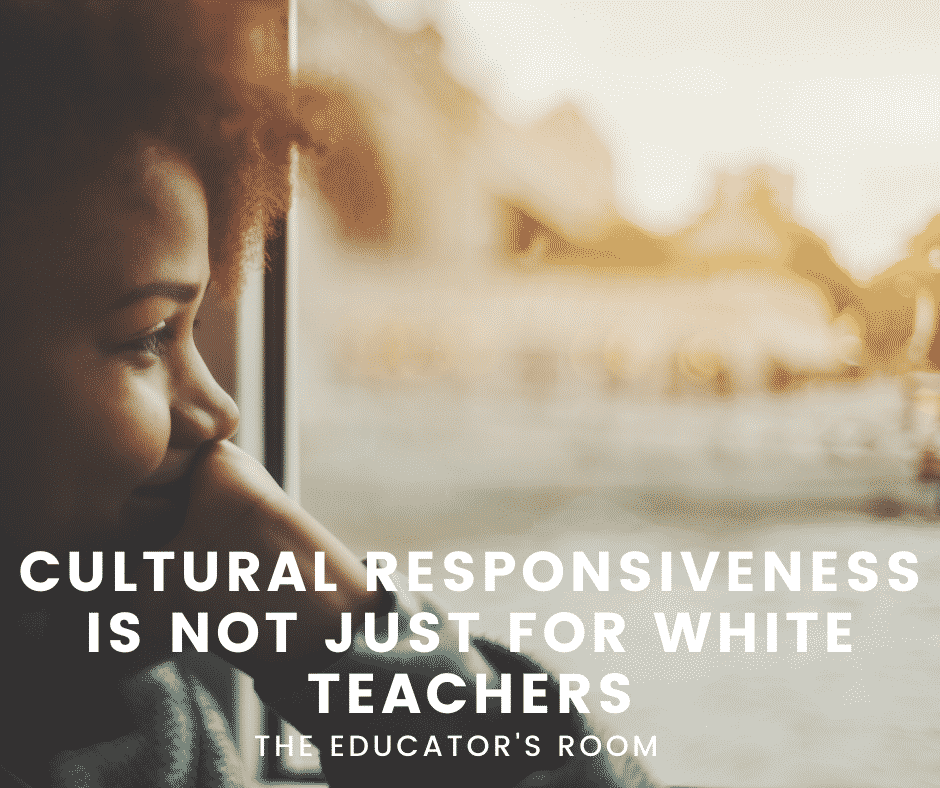I remember my first year teaching….I was having difficulty with a few of my 6th-grade students. They were male and Hispanic. I wasn’t sure what the gap was but they ignored me when I spoke, they made rude comments and made it quite clear they weren’t going to do anything that I asked (including their homework). Here I was a young, naive, African American middle school teacher and I taught in a middle school where the majority population was Hispanic. I held tightly to what I learned in undergrad in my multicultural courses. I remembered learning not to demand students look at you when you’re reprimanding them because in some cultures it’s disrespectful to look at the adult while being disciplined. I was mindful of not assuming all of my Hispanic students spoke Spanish (and how that was offensive to some).
I was mindful. I was aware. I was careful, or so I thought.
I couldn’t figure out for the life of me why I was struggling with this small group of 6th-grade males. Did I miss a cultural cue? Did I unknowingly do something to create distrust? As a black person, I thought I was aware, but I didn’t realize that even I could get it wrong. One day a fellow veteran teacher who happened to be Hispanic pulled me aside. She asked me, “Are you having trouble with those boys?’ I replied with an immediate yes and I will never forget what I was told.
She went on to tell me, “some Hispanic families hate Black people.” She went on to say, “And you’re a woman too? That’s like a double whammy. I’ve heard the conversations because some of my family members don’t like Black people either. Some think even less of you than White people. Some of those boys, I know their parents…..and you’re fighting the prejudice that they’re getting at home. Be patient. They’ll figure out you’re a good teacher.” As I was left with this heavy load just dumped on me, it took me a minute to process. It never occurred to me that I would deal with biases and prejudice-or even misconceptions about who I am from another marginalized group. Thirteen years later, I definitely know better. However, as a young teacher in a school of Black and Brown children, I didn’t think about it until that conversation.
Fast forward until now….
I am on a predominantly Hispanic campus in a predominately Hispanic district where people think that having Black students makes our school diverse. I chuckle because if a few Black children make an area diverse you haven’t seen true diversity. Throughout my educational career, I have grown to champion diversity and inclusion, cultural responsiveness, restorative, and trauma-informed practices. Particularly in our current climate, these elements are vital to a healthy campus culture. I have been accustomed to having to fight these battles of awareness with my White colleagues. Most of the diversity pieces of training I’ve sat through and/or helped facilitate have been through the black/white lens- making the black experience clear. Making folks aware of the microaggressions all students of color face. Preaching on the need for representation and why it matters so much to the mental well being and academic success of students of color and staff. There’s usually denial first, then resistance, then shock, then curiosity, then awareness…..and we are still working towards action in this current culture gap.
BUT…..
Currently, I find myself in an ironic space- a place where I find that I am having to do the same work with not only white colleagues but other colleagues of color. And I am reminded of the 24 year old naive me who thought there was an unspoken understanding across groups of color. That our similar struggles created a bond of understanding where we would just automatically relate and champion each other in the battles of race and equity. However, this is not always the case. I feel like I am in a social experiment where I am learning the nuances of cultural competence. We declare the work so necessary for our white neighbors (and it is since their power and privilege place them in a dominant seat in our country), but there is an equal amount of work to do in communities of color.
What I have learned and encountered working in a predominantly Brown space…
- How correct that veteran teacher was during my 1st year teaching. Yes, there are some families that have a clear disdain for Black people.
- How much representation students and staff have without even realizing it. I watch the faces of our Brown students light up when they walk into campus because they see themselves represented each day. Our Black students lack this representation and have a very different school experience than their Hispanic brothers and sisters.
- The code-switching between black and brown students. For example, black code-switching being unacceptable while Hispanic code-switching is acceptable. I feel both are acceptable but observing the reaction to each has been eye-opening. The office dynamic is also interesting as conversations quickly switch to Spanish when I pass by. I don’t understand much Spanish (solo pocas palabras), but I understand enough to know that it is an intentional code switch.
- The distrust of Black teachers and Black administrators from families, teachers, and staff. How trust seems automatic with white faces in the school but not black faces in the school.
- Having to play the “prove yourself” game to white colleagues AND brown colleagues alike and the double exhaustion of fighting anti-blackness in this country (and at work) is EXHAUSTING.
- The questions around Black culture including why do we have to study our history during Black History Month. However, no questioning of studying culture during Hispanic Heritage Month. The constant confusion and a lack of understanding about what it means to be Black in America (let alone an all Brown space). Also, how our experiences are still different even though we are both people of color.
- The subtle microaggressions where you feel like you have to explain why you and Black students/families matter.
- Realizing that cultures on the outskirts (Black, Asian, etc.) are expected to “blend in.” It’s an unspoken rule in the imaginary rule book of culture for any group that is not heavily represented/dominant.
Now, before you throw your tomatoes, I am not generalizing all campuses with a majority population- this is my current, lived experience. I would even say it’s fair to say that other groups of color may have their own list if immersed in a predominately Black school, Asian school, etc. Nonetheless, it has me thinking of how imperative it is to not limit the cultural competency conversation to white people. In America, people of color are fighting many similar battles, but in our own communities, we still have to do our own cultural work. At the end of the day, not pushing cultural responsiveness in communities of color is only perpetuating the biases and White supremacy that has been ingrained in American culture. And that is the greatest burden: fighting injustices from the dominant culture AND the ones in our own communities.
I implore you, if you’re white, to check your biases.
I implore you, if you’re a person of color, to check your biases.
As educators, we are one of the greatest influencers of children. As much as we don’t always want the burden of “raising kids,” the truth is: WE DO RAISE KIDS.
We have the power to change minds. Change trajectories. Change lives.
Our interactions with each other matter. Our campus culture matters.
Our cultural responsiveness and competency matter.
Our advocacy for ALL matters.
What we don’t acknowledge or unpack goes unchecked and what goes unchecked will transfer to our students. We must be active learners who are always willing to explore our own beliefs and biases about people. The next time you walk into your campus. Look around. Check the representation. Look for the outliers or those communities that are not heavily represented. What does your staff look like as a whole? Do students see themselves when they look at the faculty? Who is being uplifted? Who is not? Who is in the shadows? Do an equity check. Are all voices equally weighted? Or is your campus a replica of the same cultural burdens America holds? My greatest hope is for campuses to be a safe place where all cultures are championed, celebrated, and heard. This cannot and will not happen if we don’t do our own work.
We must check ourselves before we wreck our students because our country and future society depends on this work. And it’s not just for White people. Be the change.






